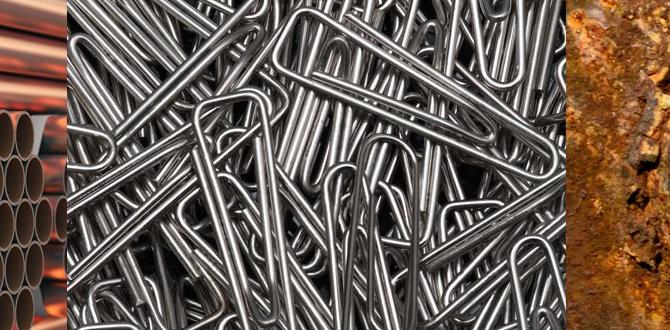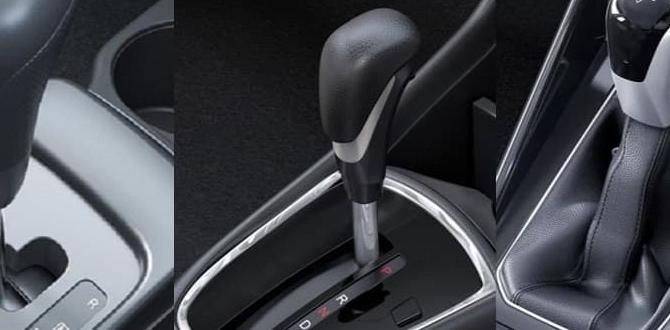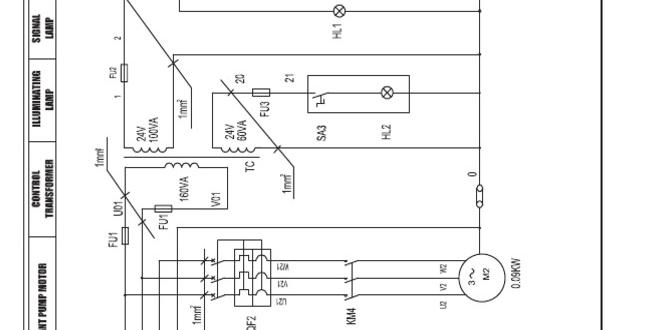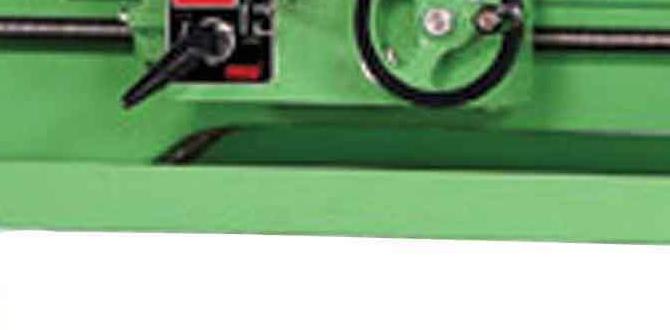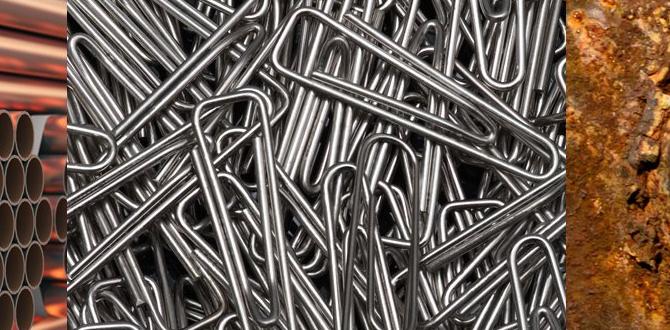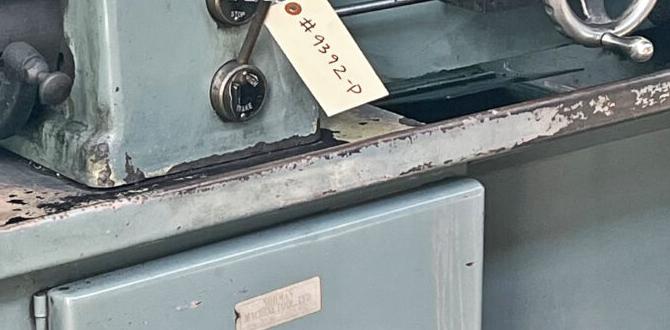A 45-degree TiALN ball nose end mill is your best friend for creating clean, precise pockets in bronze. Its specific geometry and coating make it ideal for this task, preventing tool chatter and ensuring a smooth finish, especially in smaller cavities.
Working with bronze can be a rewarding experience, offering a beautiful finish and excellent machinability. However, creating intricate shapes like pockets requires the right tools and techniques. Have you ever struggled to get a clean, smooth finish inside a small bronze pocket? It’s a common challenge for beginners and even experienced machinists. The good news is, with the right end mill, this task becomes much simpler and more predictable. Today, we’re diving into why a 45-degree TiALN ball nose end mill is the perfect solution for your bronze pocket projects. We’ll explore what makes it special and how to use it effectively.
Why Bronze Pockets Can Be Tricky
Bronze, while generally easy to machine, can present some unique challenges when you need to create detailed pockets. Its relative softness can lead to tools picking up material, resulting in a gummy surface finish. If the tool isn’t quite right, you can experience vibration, or “chatter,” which leaves undesirable marks on your workpiece and reduces tool life. For small pockets, these issues are amplified because there’s less room for error and less material to stabilize the cutting action. Getting sharp corners and smooth walls without leaving burrs or rough patches requires precision. This is where specialized tooling truly makes a difference.
Understanding the TiALN Ball Nose End Mill
Let’s break down what makes this specific tool so effective for bronze pockets.
The Ball Nose Shape
A ball nose end mill has flutes that meet at a rounded tip, forming a hemispherical cutting surface. This shape is crucial for creating contoured shapes and can also be used for finishing operations. For pockets, the rounded tip allows for smooth entry into the material and can mill full-radius fillets at the bottom of pockets, which is often a desired feature. Unlike flat-bottomed end mills, a ball nose can machine a radiused corner, eliminating stress points and enhancing the aesthetic appeal of your work.
The 45-Degree Helix Angle
The helix angle refers to the slant of the cutting edges (flutes) along the tool’s body. A 45-degree helix angle is a good compromise for many materials, including bronze. It provides a moderate rake angle, which helps in efficiently shearing the material. This angle helps to reduce the cutting forces and chip load compared to tools with steeper helix angles (like 90 degrees for a square end mill) or shallower helix angles. For materials like bronze, which can be somewhat “gummy,” this moderate angle helps to clear chips effectively without clogging the flutes, leading to a cleaner cut and preventing material buildup on the tool.
The TiALN Coating
TiALN stands for Titanium Aluminum Nitride. This is a hard, wear-resistant coating applied to the surface of the end mill. Why is this important for bronze machining?
- Improved Hardness: The coating significantly increases the surface hardness of the tool, making it more resistant to wear and abrasion.
- Reduced Friction: TiALN acts as a lubricant at high temperatures, reducing friction between the tool and the workpiece. This means less heat is generated during cutting, which is vital for preventing material from welding onto the cutting edges.
- Higher Cutting Speeds: Because of its heat resistance and hardness, TiALN coated tools can often run at higher surface speeds and feed rates, leading to faster machining times without sacrificing tool life.
- Oxidation Resistance: TiALN coatings can withstand higher operating temperatures before they start to oxidize, further extending tool life, especially in demanding applications.
When machining bronze, especially at higher speeds or with longer cuts, the heat generated can be substantial. The TiALN coating helps manage this heat and prevents the bronze from sticking to the end mill, ensuring a clean and consistent cut. For more information on tool coatings, you can refer to resources like the Sandvik Coromant technical articles on machining coatings.
Key Benefits for Machining Bronze Pockets
Combining the ball nose shape, 45-degree helix, and TiALN coating creates a powerful tool specifically suited for bronze pockets. Here’s why:
- Superior Surface Finish: The ball nose allows for smooth, sweeping cuts, while the 45-degree helix angle and TiALN coating reduce friction and heat, leading to a mirror-like finish in the pocket.
- Reduced Chattering: The balanced geometry of a 45-degree helix end mill is less prone to vibration or chatter in softer materials like bronze, ensuring consistent depth and wall accuracy.
- Improved Chip Evacuation: Even though bronze can be gummy, the flutes designed for a 45-degree helix help to efficiently break and clear chips, preventing them from clogging the cutter and causing tool breakage or poor finish.
- Enhanced Tool Life: The TiALN coating protects the end mill from wear and heat, meaning it will last longer, especially when working with materials that can be abrasive or prone to welding to the tool.
- Versatility: While ideal for pockets, this type of end mill is also great for contoured surfaces, radiused fillets, and general milling tasks.
When to Choose a 45-Degree TiALN Ball Nose End Mill for Bronze Pockets
This specialized end mill shines in several scenarios:
- Creating radiused bottom pockets: If you need a smooth, continuous radius at the bottom of your pocket, a ball nose is essential.
- Achieving a high-quality surface finish: For parts where appearance matters, this tool delivers a superior finish.
- Machining small or intricate pockets: Where tool engagement is shallow, the balanced cutting action is crucial.
- When dealing with potential tool chatter: The 45-degree helix helps to mitigate vibration.
- Maximizing tool life: The TiALN coating extends the life of the end mill, especially in demanding bronze applications.
It’s important to note that for very large pockets or roughing operations, a different tool might be more efficient. However, for the critical task of finishing or creating detailed pockets in bronze, the 45-degree TiALN ball nose is hard to beat.
Essential Setup and Machining Parameters
To get the best results, proper setup and machining parameters are key. Even with the perfect tool, incorrect settings can lead to poor performance. For beginners, starting conservatively with speeds and feeds is always a good practice.
Choosing the Right Spindle Speed (RPM)
The spindle speed determines how fast the tool rotates. For bronze and a typical 45-degree TiALN ball nose end mill, a good starting point can be found by considering the material and the tool’s diameter. A common range for machining bronze with carbide tooling is between 200-800 SFM (Surface Feet per Minute). To convert SFM to RPM, you use the formula: RPM = (SFM 3.25) / Diameter (inches).
Example: For a 1/4 inch diameter end mill operating at 400 SFM:
RPM = (400 3.25) / 0.25 = 1300 / 0.25 = 5200 RPM
Always consult your tool manufacturer’s recommendations if available. Start at the lower end of the recommended range and gradually increase if the cut is smooth and chip formation is good.
Setting the Feed Rate (IPM)
The feed rate is how fast the tool moves through the material (usually measured in Inches Per Minute, IPM). Chip load is the amount of material removed by each cutting edge per revolution. A good chip load for bronze with a 45-degree ball nose end mill might range from 0.001 to 0.005 inches per tooth, depending on the tool diameter and rigidity of the setup.
The formula for IPM is: IPM = Chip Load per Tooth Number of Teeth RPM.
Example: For a 1/4 inch diameter, 2-flute end mill, with a target chip load of 0.003 inches/tooth, at 5200 RPM:
IPM = 0.003 2 5200 = 0.006 * 5200 = 31.2 IPM
Again, start conservatively. Listen to the cut. If chips are too thin and wispy, you might be feeding too fast or cutting too shallow (light passes). If chips are large and stringy, you might be feeding too slow or the RPM is too high. The goal is to produce small, manageable chips.
Depth of Cut (DOC) and Stepover
Depth of Cut (DOC): This is how deep the tool cuts into the material with each pass. For finishing operations, especially with ball nose mills creating contoured surfaces or pockets, a shallower DOC is often used. A radial depth of cut (for wall engagement) and an axial depth of cut (for how deep each pass goes) are important. For finishing, you might take axial depths of 0.050″ to 0.100″ or even shallower, depending on the pocket depth and tool diameter.
Stepover: This is the distance the tool moves sideways between passes (radial engagement). For finishing, a typical stepover for a ball nose end mill might be between 10% and 40% of the tool’s diameter. A smaller stepover will result in a smoother surface finish but will take longer to machine.
Coolant and Lubrication
While bronze is relatively easy to machine, using some form of coolant or lubrication is always beneficial. It helps to:
- Reduce heat buildup.
- Improve chip evacuation.
- Prevent the bronze from welding to the tool.
- Achieve a better surface finish.
For bronze, a light cutting fluid, mist coolant, or even just some WD-40 can be sufficient for smaller operations. For larger or more production-oriented jobs, a flood coolant system is ideal. Ensure your machine is set up safely and appropriately for the coolant you choose.
Step-by-Step Guide: Machining a Bronze Pocket
Here’s a general workflow for using your 45-degree TiALN ball nose end mill to create a pocket in bronze. Always ensure your workpiece is securely fixtured and you are wearing appropriate safety gear, including eye protection.
Preparation Steps
- Secure Your Workpiece: Ensure the bronze block is rigidly clamped in your milling machine vise or fixture. Double-check that it cannot move during the machining process.
- Tool Installation: Insert your 45-degree TiALN ball nose end mill into the collet or tool holder. Make sure it’s seated properly and tightened securely.
- Zeroing the Tool: Carefully set your X, Y, and Z axes zero points. This is critical for accurate pocket dimensions.
- Material Inspection: Ensure the bronze is clean and free of any debris that could interfere with the cut.
Machining Process
- Program Your Toolpath (CAM Software or Manual):
- Define the pocket shape and its exact dimensions.
- Select your 45-degree TiALN ball nose end mill as the cutting tool.
- Input your calculated or recommended RPM, feed rate, depth of cut, and stepover.
- For pockets, you’ll typically use a pocketing or contouring strategy. A standard pocketing strategy will mill out the bulk of the material, while a contouring strategy can be used for fine finishing passes along the walls.
- Important: If you’re manually programming or using a simple milling machine, plan your passes. You might use a larger tool for roughing out most of the pocket and then use your ball nose end mill for a finishing pass to create the final shape and fine surface finish.
- Make Your First Pass (Dry Run Recommended): If using CNC, it’s wise to perform a “dry run” with the spindle turned off to check tool paths and clearances.
- Engage Spindle and Coolant: Start the spindle to your programmed RPM and activate your coolant or lubrication system.
- Initiate the Cut: Begin the machining process according to your program or manual operation.
- Monitor the Cut: Listen to the sound of the cutting action. Smooth sounds indicate a good cut. Grinding, squealing, or loud knocking can indicate issues (e.g., wrong speeds/feeds, dull tool, loose fixture). Watch for chip formation – they should be small and consistent.
- Subsequent Passes: The machine will continue to make passes according to your programmed depths and stepovers.
Finishing Touches
- Final Pass(es): If your strategy includes a dedicated finishing pass with a very small stepover and potentially a slightly adjusted feed rate, ensure this is executed flawlessly. Ball nose end mills are excellent for these smooth, final cleaning-up operations.
- Retract Tool: Once the pocket is complete, safely retract the tool from the workpiece.
- Clean Up: Turn off the spindle and coolant. Remove the workpiece from the machine. Clean the pocket to remove any chips or coolant residue. Inspect the pocket for accuracy and surface finish.
Tool Selection and Considerations
When selecting your 45-degree TiALN ball nose end mill, keep these points in mind:
Material of the End Mill
For machining operations like this, Solid Carbide end mills are generally preferred over High-Speed Steel (HSS). Carbide offers:
- Higher hardness and rigidity.
- Better heat resistance, allowing for faster cutting speeds.
- Improved wear resistance, leading to longer tool life.
While HSS can work for some softer materials, solid carbide is the standard for most modern machining, especially when coatings like TiALN are involved. The hardness of carbide also allows it to maintain its cutting edge more effectively at the higher temperatures generated, which is where the TiALN coating really shines.
Number of Flutes
For bronze, tools with 2 or 3 flutes are often ideal.
- 2 Flutes: Offer excellent chip clearance, which is important for gummy materials like bronze. They are also generally more rigid for a given diameter.
- 3 Flutes: Provide a smoother cutting action and can sometimes achieve a better surface finish due to more cutting edges engaging the material, but chip evacuation can be slightly more challenging than with 2-flute tools.
For general-purpose pocketing and finishing in bronze, a 2-flute end mill is often a safe and effective choice, especially if you’re concerned about chip buildup. If your machine is very rigid and you have good chip management, a 3-flute can also perform well.
Diameter
The diameter of the ball nose end mill you choose will depend on the size of the pocket you need to create. For small pockets, you’ll want a smaller diameter end mill. However, bear in mind that smaller diameter tools are more fragile and require lighter cuts and more careful handling. They also have a higher rotational speed requirement to achieve the same surface feet per minute.
For small pockets, a 1/8″ (3mm) or 1/4″ (6mm) diameter end mill is common. Always ensure your tool diameter is appropriate for the features you are milling. A good rule of thumb is that the tool diameter should be no larger than the smallest radius you need to cut, and often smaller for easier maneuverability.
Tool Holder Rigidity
The quality of your tool holder and collet system is paramount. A worn or runout-prone tool holder can negate the benefits of even the best end mill. Ensure your collets are clean and properly sized for the end mill shank. For critical applications, consider using high-precision tool holders.
Safety First!
Machining, even with beginner-friendly tools, requires a strong commitment to safety. Always:
- Wear Safety Glasses: Always wear ANSI Z87.1-compliant safety glasses. A face shield provides even better protection.
- Secure Workpiece: Ensure your workpiece is firmly clamped. A loose workpiece can become a dangerous projectile.
- Proper Tooling: Use sharp tools that are appropriate for the material and operation. Dull or incorrect tooling can lead to unexpected forces and tool breakage.
- Machine Guarding: Keep all machine guards in place.
- Clear Chunks: Never attempt to clear chips with your hands while the machine is running. Use a brush or compressed air (with appropriate precautions).
- Emergency Stop: Know where your machine’s emergency stop button is and how to use it.
- Read Manuals: Familiarize yourself with the operating manuals for your milling machine and any CNC controllers.
Working safely isn’t just about preventing accidents; it’s about building good habits that will serve you throughout your machining journey.

